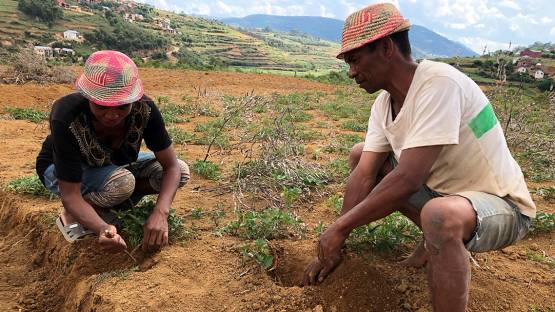Talatabely, Madagascar – Joseph Randriarimalala and Bodonirina Rasoloarisoa, a farming couple in central eastern Madagascar, noticed that their half hectare land was becoming less and less fertile and producing lower yields, but they did not know why and what to do. Now they do – degradation of their land is the result of increased soil erosion due to the farming approach they used to employ on their hilly terrain.
“We used to plant seeds right on the slopes, using machinery to turn the soil around. It turns out that this can lead to a loss of the topsoil layer, the most fertile part of the soil,” said Randriarimalala. Scientists from the country’s National Institute of Nuclear Science and Technology (INSTN Madagascar) used an isotopic technique to evaluate the level of soil erosion on the couple’s plot (see Fallout radionuclides help to assess soil erosion) – and then used the results to advise farmers in similar situation across the country.
According to the Food and Agriculture Organization of the United Nations (FAO), around one third of the island’s land resources are degraded – mostly due to erosion. Erosion does not only deplete the soil, but at the same time impacts terrestrial ecosystems and their biodiversity, and when the eroded soil ends up in rivers and lakes, it affects the viability of aquatic ecosystems as well. It is therefore important to establish effective conservation strategies, said Emil Fulajtar, a soil scientist at the Joint FAO/IAEA Division of Nuclear Techniques in Food and Agriculture, who advised ISTN scientist on the matter. Erosion hotspots and the effect of the conservation strategies were determined using isotopes.
The studies have revealed that on cultivated land in the country’s Central Highlands over 10 tons/hectare of soil are lost on unprotected slopes every year as a result of a combination of farming practices, the lack of land cover and natural causes such as wind and heavy rain. The solution the INSTN researchers recommended to farmers was to switch to terrace farming, in which measurements revealed the loss of fertile soil was only 5 tons per hectare per year, said Naivo Rabesiranana, who headed the research at INSTN. “This is still a lot as compared to forested areas, but it is much less than before,” he said.






